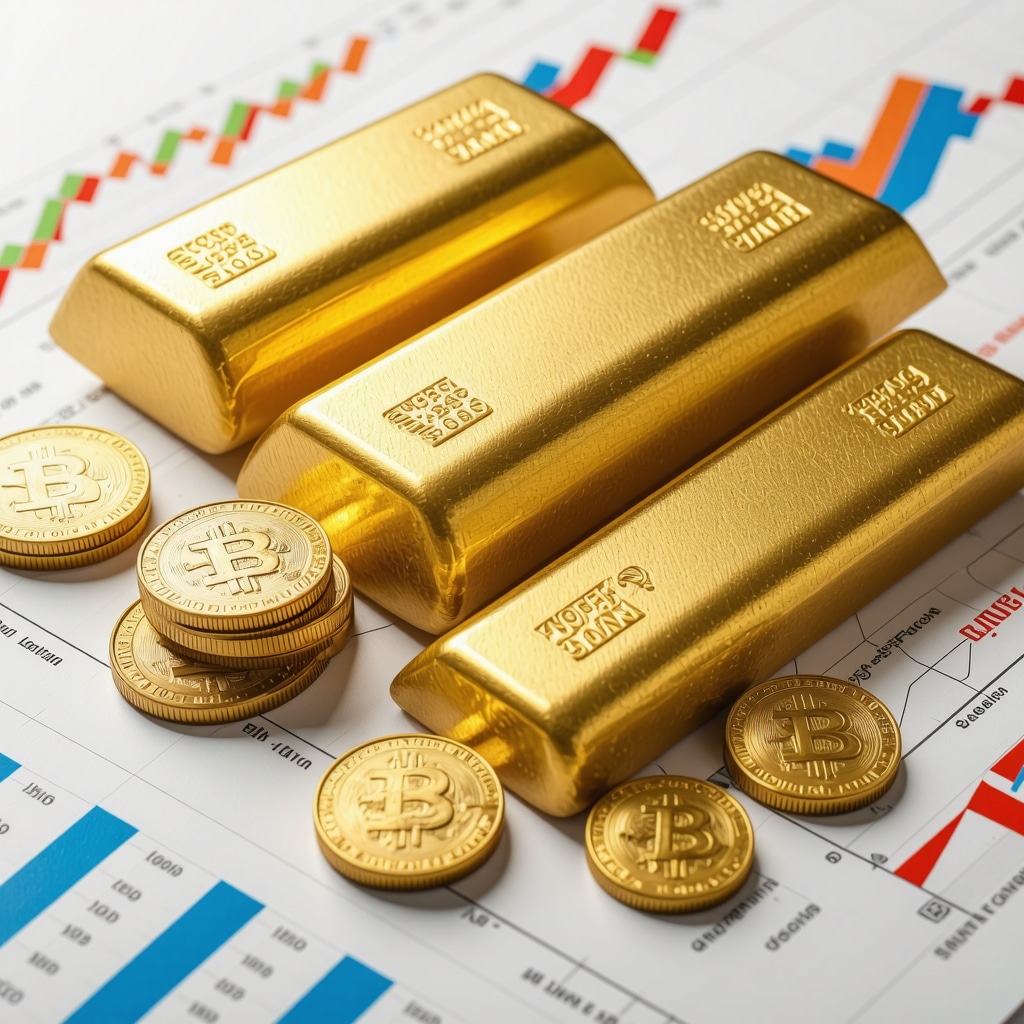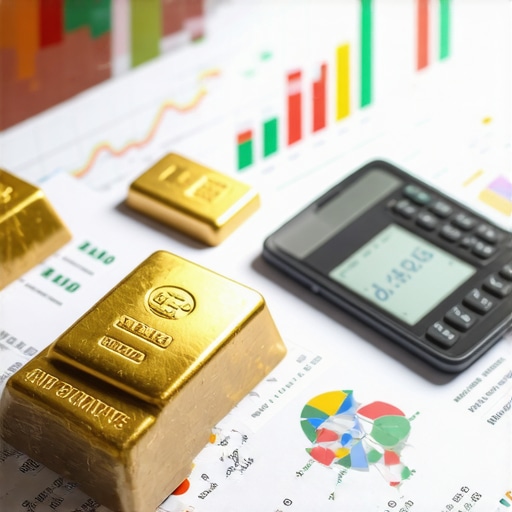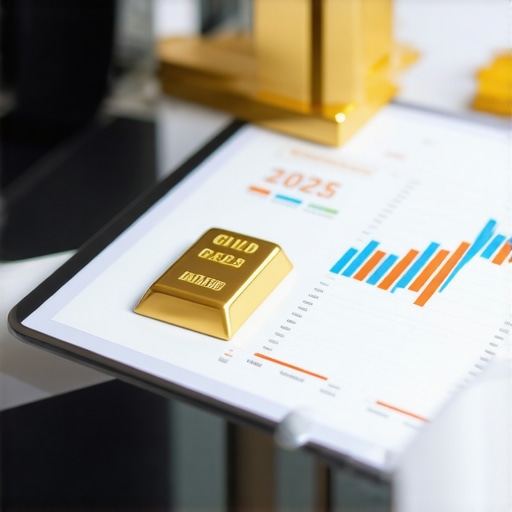How I Discovered the Power of Gold ETFs and Mutual Funds
When I first started investing, I was captivated by the stock market’s potential but soon realized how volatile it could be. My quest for stability and diversification led me to explore gold investments. Initially, I dabbled in physical gold, but the hassle of storage and security concerns nudged me toward financial instruments like gold ETFs and mutual funds. This shift transformed my portfolio by providing exposure to gold’s enduring value without the logistical headaches.
Why Gold ETFs Became My Go-To for Diversification
Gold ETFs offer the convenience of trading like stocks while tracking the price of gold, making them incredibly accessible. What I appreciate most is how they help balance my portfolio against market uncertainties and inflation. In fact, according to Investopedia, gold ETFs combine liquidity with the safety of gold, a trait that’s invaluable in uncertain economic times. Plus, investing in ETFs like SPDR Gold Shares (GLD) or iShares Gold Trust (IAU) has allowed me to maintain liquidity while benefiting from gold’s performance.
Mutual Funds: A Different Flavor of Gold Exposure
While ETFs are straightforward, I found gold mutual funds intriguing because they often invest not only in physical gold but also in gold mining companies. This dual exposure provides a different risk-return profile. My experience with funds like the Vanguard Precious Metals and Mining Fund has shown me how mutual funds can offer growth potential through active management, which sometimes outperforms the gold price alone.
How Do I Choose Between Gold ETFs and Mutual Funds?
This question often comes up when I chat with fellow investors. My approach is to consider investment goals and risk tolerance. ETFs are great for hands-off, cost-effective exposure, while mutual funds might appeal if you’re seeking professional management and potential for higher returns, albeit with higher fees. For a comprehensive comparison, I found this detailed analysis on comparing gold mutual funds and ETFs quite enlightening.
Integrating Gold into a Diversified Portfolio: Lessons Learned
In my portfolio, I allocate a modest percentage to gold ETFs and mutual funds to hedge against inflation and market volatility. This strategy has provided peace of mind, especially during economic downturns. The beauty of these instruments lies in their ability to diversify without complicating my investment management. For those interested in diving deeper, exploring how to build a diversified portfolio with gold ETFs can be a great next step (read more here).
I’d love to hear about your experiences with gold ETFs or mutual funds. What strategies have worked for you? Feel free to share your thoughts and questions in the comments below!
Advanced Strategies for Optimizing Gold ETF and Mutual Fund Investments
Once you’ve established a foothold in gold ETFs and mutual funds, the next step is to refine your strategy to maximize returns while managing risk. I’ve found that timing and understanding market cycles play crucial roles. Gold’s price often correlates inversely with the U.S. dollar and real interest rates, so monitoring these macroeconomic indicators can enhance decision-making. For instance, during periods of rising inflation or geopolitical uncertainty, increasing exposure to gold-focused funds can provide a better hedge.
Additionally, layering your investments between physical gold, ETFs, and mutual funds offers a nuanced approach that balances liquidity, growth potential, and security. Physical gold acts as a tangible asset shield, while ETFs provide ease of trading and mutual funds introduce professional management with potential alpha from mining equities.
Understanding the Impact of Global Gold Demand Trends on Fund Performance
Gold demand trends, driven by factors such as jewelry consumption, central bank purchases, and technological applications, heavily influence the performance of gold-related investments. The surge in central bank gold acquisitions by emerging economies has been particularly notable, bolstering fund valuations. Moreover, shifts in consumer preferences toward sustainably sourced gold are beginning to affect mining companies’ valuations, which mutual funds often hold.
Being informed about these demand dynamics can guide fund selection and timing. For deeper insights, the article on understanding global gold demand trends and market impact offers comprehensive analysis that can enrich your investment perspective.
How Can Investors Leverage Gold ETFs and Mutual Funds to Navigate Rising Inflation?
As inflation pressures mount globally, gold’s status as a traditional inflation hedge comes into sharp focus. Investors might wonder how best to position themselves within gold ETFs and mutual funds to capitalize on this trend. From my experience, ETFs tracking physical gold provide direct exposure to gold price inflation, making them suitable for short to medium-term inflation hedging. Conversely, mutual funds that invest in mining equities may offer leveraged upside but with increased volatility, which requires a longer-term investment horizon.
Balancing these instruments within your portfolio according to your risk tolerance and investment goals is vital. For practical strategies, exploring top gold investment strategies to hedge against inflation could provide actionable guidance.
I encourage readers to share their own strategies for using gold ETFs and mutual funds during inflationary periods or economic uncertainty. Your insights could benefit the community, so please comment below or share this article with fellow investors looking for smart diversification tactics.
Reflecting on the Emotional Side of Gold Investing
Investing in gold ETFs and mutual funds isn’t just a mechanical process for me—it’s deeply intertwined with my emotional journey as an investor. I recall moments during market turbulence when my gold holdings provided a comforting sense of security, even when other assets faltered. Yet, this emotional reassurance can sometimes cloud judgment if one isn’t careful. Balancing the instinct to seek safety with disciplined strategy has been a subtle but vital lesson. Understanding this interplay helped me avoid impulsive decisions, especially when gold prices swing sharply.
The Role of Timing and Patience in Gold Fund Investments
Gold ETFs and mutual funds are often perceived as straightforward vehicles, but timing entry and exit points remains a nuanced art. Early in my experience, I learned that chasing gold during hype cycles often led to suboptimal outcomes. Instead, I adopted a patient approach, aligning my increases in gold exposure with macroeconomic signals like real interest rate movements and geopolitical tensions. Resources like this detailed forecast helped me anticipate potential price drivers, allowing more informed decisions rather than reactive moves.
How Do I Evaluate the Quality and Management of Gold Mutual Funds?
One of the trickier aspects I’ve encountered is assessing gold mutual funds beyond their surface-level performance. Unlike ETFs that typically track physical gold prices, mutual funds’ returns hinge heavily on the management team’s expertise, investment philosophy, and responsiveness to market changes. I’ve found it invaluable to dig into fund managers’ track records, their approach to mining stock selection, and their risk management strategies. For instance, some funds emphasize sustainability and ethical mining practices, reflecting emerging trends that might affect long-term valuations.
Checking detailed fund analyses, like those found in top mutual funds reviews, has been a cornerstone of my evaluation process. It’s not just about past performance but also about how adaptable and forward-looking a fund’s strategy is.
Incorporating Global Economic Indicators Into My Gold Strategy
My investment approach has matured to incorporate a broader macroeconomic lens. Gold’s price doesn’t move in isolation; it dances with variables like currency strength, inflation expectations, and central bank policies. Observing these indicators in real-time has allowed me to adjust my gold allocation dynamically. For example, during periods when the dollar weakens or inflation expectations rise, I tend to increase my gold ETF holdings to capture upside potential.
This deeper understanding was sparked by insights from comprehensive analyses of global gold demand. It’s fascinating how shifts in demand from emerging markets or central bank buying can ripple through fund performance. Recognizing these subtle signals has been a game-changer in refining my portfolio.
Exploring the Balance Between Liquidity and Growth Potential
Gold ETFs have been my go-to when liquidity is paramount—quick trades, easy portfolio rebalancing, and immediate price reflection. Mutual funds, however, offer a different flavor: growth potential through exposure to gold mining companies, which can outperform physical gold in bullish markets. My strategy now often blends these two, allowing me to enjoy the best of both worlds.
Yet, this blend requires constant reassessment. Mining stocks come with operational risks and market sentiment swings that can amplify volatility. Tracking these elements and adjusting weights accordingly has been part of my ongoing learning curve. For those interested, I’d recommend reviewing comparative insights to tailor your approach.
What Are the Hidden Costs and Risks I’ve Learned to Watch?
Beyond obvious fees, I’ve discovered that gold ETFs and mutual funds carry nuanced risks that deserve attention. For ETFs, tracking errors and liquidity under stress conditions can impact returns subtly. Mutual funds might suffer from higher expense ratios, potential management turnover, and sector concentration risks, especially if heavily weighted in a few mining giants.
Understanding these hidden layers has made me more vigilant. I now scrutinize expense ratios, fund size, turnover rates, and even the geopolitical footprint of mining operations held by funds. This diligence ensures I’m not blindsided by factors that might erode returns or amplify risks unexpectedly.
If you’re navigating these complexities too, I’d love to hear your thoughts or strategies. Sharing experiences can help us all build smarter, more resilient gold investment approaches.
Navigating the Complexities of Gold Market Volatility with Strategic Fund Allocation
Over the years, I’ve come to appreciate that gold investing isn’t a static endeavor; it requires adaptive strategies that reflect shifting market dynamics. One realization that reshaped my approach was understanding how gold ETFs and mutual funds react differently to volatility. For example, during episodes of sharp price fluctuations, ETFs tend to mirror immediate gold spot price changes, offering nimble liquidity. Meanwhile, mutual funds, especially those invested in gold mining equities, often experience amplified swings due to operational risks and market sentiment. This duality necessitates a careful balancing act to harness growth opportunities without succumbing to undue volatility.
To fine-tune this balance, I frequently consult advanced market analyses that dissect gold price drivers beyond surface trends. A recent in-depth report by the World Gold Council elucidates how geopolitical tensions, monetary policy shifts, and currency movements intertwine to influence gold fund performance at a granular level. Integrating these insights into my decision-making process has sharpened my timing and allocation tactics significantly (World Gold Council’s Latest Gold Demand Trends).
Harnessing the Synergy Between Gold ETFs, Mutual Funds, and Alternative Gold Investments
Expanding beyond traditional ETFs and mutual funds, I’ve explored complementary gold investment avenues such as gold futures, royalty companies, and even selective physical gold holdings. This layered strategy not only diversifies risk but also maximizes exposure to various facets of the gold ecosystem. For instance, royalties and streaming companies offer a unique growth vector by capitalizing on the mining sector’s upside without direct operational risks. Incorporating these instruments alongside ETFs and mutual funds enhances portfolio resilience and performance potential.
How Do I Adjust My Gold Investment Mix in Response to Macro-Financial Shifts?
Responding to macroeconomic changes remains a cornerstone of my evolving gold strategy. When inflationary pressures escalate or real interest rates dip into negative territory, I tend to increase my allocation to physical gold and ETFs, which provide direct exposure to gold price appreciation. Conversely, during periods of economic recovery or rising interest rates, I pivot toward gold mutual funds and mining equities to capture leveraged upside potential.
This dynamic rebalancing is informed by monitoring key indicators such as the U.S. dollar index, Federal Reserve policy signals, and emerging market central bank gold purchases. For those interested in enhancing their strategic toolkit, exploring understanding gold demand trends insights can provide a robust framework for anticipating market shifts.
Engaging with the gold investment community has also deepened my perspective; sharing experiences and strategies fosters collective wisdom that no single analysis can fully capture. I invite you to share your nuanced approaches or questions below—let’s elevate our gold investing acumen together.
Things I Wish I Knew Earlier (or You Might Find Surprising)
The Emotional Comfort of Gold Goes Beyond Numbers
When I first invested in gold ETFs and mutual funds, I focused mainly on the numbers — returns, fees, benchmarks. Over time, I realized gold also offers an emotional anchor during turbulent markets. That sense of security isn’t just psychological fluff; it can help you stay calm and avoid rash decisions when other assets falter.
Not All Gold Mutual Funds Are Created Equal
Early on, I assumed all gold mutual funds would behave similarly since they’re tied to the same metal. But the reality is that management style, mining stock choices, and even ethical considerations can cause big performance differences. Digging into fund managers’ strategies and sustainability focus opened my eyes to what really drives long-term returns.
Liquidity Isn’t Just a Convenience — It’s a Hedge
I underestimated how much liquidity in gold ETFs gave me flexibility to rebalance quickly when market conditions shifted. Mutual funds, while offering growth potential, sometimes felt like a slower ship. Having a blend means I can pivot fast with ETFs while holding mutual funds for strategic growth.
Global Demand Trends Matter More Than You Think
It wasn’t until I studied central bank purchases and emerging market demand that I truly appreciated how global factors influence gold fund performance. These trends ripple through prices and valuations in ways that aren’t obvious from just watching spot gold prices. Staying informed about these dynamics has helped me anticipate market moves better.
Timing Is Subtle, Not Obvious
Gold investing isn’t about jumping in when the hype is loudest. I learned that patience and watching macroeconomic signals — like real interest rates and currency moves — make all the difference. This nuanced timing approach has saved me from chasing fleeting peaks and helped me build a more resilient portfolio.
Resources I’ve Come to Trust Over Time
World Gold Council — Their latest gold demand trends reports are my go-to for understanding how global shifts impact gold investments. The data and insights feel credible and actionable.
Investopedia — For clear, approachable explanations like their overview of gold ETFs, I often recommend this site to friends just starting out or wanting a refresher.
Buying Gold Now — This site is packed with practical guides and up-to-date analysis, like comparing gold mutual funds and ETFs. I trust their well-researched content because it blends market insight with real-world investor perspectives.
Morningstar — When evaluating mutual funds, Morningstar’s detailed ratings and manager profiles have been invaluable to me in assessing fund quality beyond just returns.
Parting Thoughts from My Perspective
Investing in gold ETFs and mutual funds has been a journey of discovery, blending practical strategy with emotional resilience and ongoing learning. Gold’s unique role as both a hedge and growth asset means it deserves thoughtful integration into a diversified portfolio. What’s worked for me is embracing patience, staying curious about global economic signals, and balancing liquidity with growth potential.
If this resonated with you, I’d love to hear your thoughts or experiences. Share your story or questions in the comments below — after all, learning from each other is one of the richest returns.










